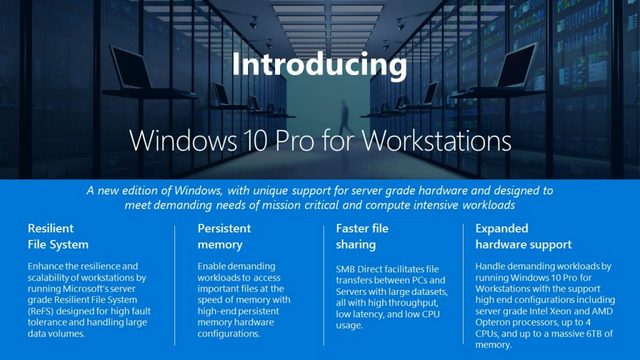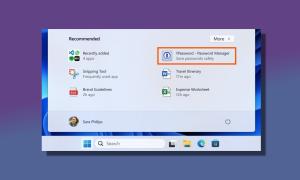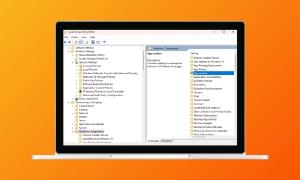When Microsoft stated that Windows 10 was going be to the last edition of the Windows series, they certainly did not mention the number of editions that Windows 10 itself will have. That being said, Microsoft recently announced a new edition for their Windows 10 line of operating systems, named “Windows 10 Pro for Workstations”, making it the 12th member in the Windows 10 family. If you are wondering what’s new in this edition, this article has you covered. So without any further ado, here is everything you need to know about Windows 10 Pro for Workstations:
What is Windows 10 Pro for Workstations?
Simply put, Windows 10 Pro for Workstations is a high-end version of the already existing Windows 10 Pro. Coming into picture from the feedback provided by various Windows 10 users through the Windows Insider Program, it is aimed at delivering a better and smoother experience to the users who use high-end PCs. This new edition will come with a unique support for server-grade PC hardware and is designed to support mission-critical workloads.
Though, as a consumer, you may not really be able to test it to its full potential, if you user high-end PC full-blast with Windows 10 Pro for Workstations, your computer will work more responsibly and reliably. So, theoretically, you should be able to leverage the full power of your computer’s hardware. Now to know more details about it, let’s take a quick look at its key features.
Key Features of Windows 10 Pro for Workstations
There are four major improvements that will make Windows 10 Pro for Workstations the beast it appears to be. Here is a quick description of each of them:
-
Resilient File System (ReFS)
Resilient File System or ReFS is a Microsoft propriety file system that is supposed to be the next big file system after NTFS. To give you a quick comparison, NTFS can handle volumes up to 256 TB whereas ReFS can handle, theoretically, up to 4.7 zettabytes (1 zettabyte = 1 billion TB)!
ReFS handles very large volumes with ease and comes with a few advantages like data scrubbing, protection against data degradation, handling of hard disk drive failure and redundancy, and integrity checking on mirrored storage spaces. This means that ReFS will detect if any of your data becomes corrupt on any of your mirrored drives, and then replace it with the same healthy data in the other drive.
-
Persistent Memory
Persistent memory is a method that stores data efficiently in a way that it can be accessed even after you switch your workstation off. This becomes possible as it uses the NVDIMM-N hardware which is a non-volatile memory with an on-board memory power source. Using this will help even the most demanding apps and data with the performance they require in order to work to their full potential.

-
Faster File Sharing
Windows 10 Pro for Workstations will come with built-in SMB Direct which is an extension of the Server Message Block technology. The “Direct” in “SMB Direct” implies that it will also support the use of network adapters that have Remote Direct Memory Access (RDMA) capability. One of the biggest advantages of such network adapters is that each one of them can function at full speed with both a very low latency that provides extremely fast responses to network requests and a very low CPU usage that leaves more power available to other applications running on the system.
For workloads such as Hyper-V or Microsoft SQL Server, or for applications that access large data sets on remote SMB file shares, SMB Direct also allows an increased throughput where the network adapters coordinate the transfer of large volumes of data at line speeds.
-
Expanded Hardware Support
As the name itself suggests, expanded hardware support means that Windows 10 Pro for Workstations will now support configurations more than the lower editions of Windows 10. If you are an user with a high-performance computer and server-grade Intel Xeon or AMD Opteron processors, you can now use your computers with up to 4 CPUs and a memory of up to 6 TB.
Windows 10 Pro Workstation Edition vs Windows 10 Pro
Now that you know about the key features of Windows 10 Pro for Workstations, the next question that may arise in your mind is how does it differ from the already existing Windows 10. While all the major changes that you will notice have been explained in the previous section, I’ve compared the specifications of the two editions in the table below.
| Windows 10 Pro for Workstations | Windows 10 Pro | |
| Primary File System | ReFS | NTFS |
| NVDIMM-N Support | Yes | No |
| SBM Direct | Yes | No |
| Latency | Low | Comparatively higher |
| Data Volume Handling Limit | 256 TB | 4.7 ZB |
| CPU Usage | Low | Comparatively higher |
| Max. CPUs | 4 | 2 |
| Max. Memory | 6 TB | 2 TB |
Hardware Requirements for Windows 10 Pro for Workstations
As of now, Microsoft hasn’t yet announced the minimum hardware requirements to run Windows 10 Pro for Workstations. Even though it is primarily aimed at server-based PCs and the people who manage them, I don’t think the requirements should differ from what they are for the other Windows 10 editions that we have already seen. And if this is true, the minimum hardware requirements for Windows 10 Pro for Workstations should be as follows:
| Processor | 1 GHz or faster, or SoC |
| RAM | 1 GB for 32-bit / 2 GB for 64-bit |
| Hard Disk Space | 16 GB for 32-bit / 20 GB for 64-bit |
| Graphics Card | DirectX 9 or later with WDDM 1.0 driver |
| Display | 800x600 |
When is Windows 10 Pro for Workstations Coming?
Windows 10 Pro for Workstations will be delivered as a part of the Fall Creators Update. As for its pricing, we are yet to hear about that from Microsoft. Also, I wouldn’t be surprised if Microsoft launches a killer hardware to go with this OS as well. Right now, I am betting on a new variant of Surface Studio optimized for Windows 10 Pro for Workstations.
SEE ALSO: Windows 10 Fall Creators Update: All The New Features and Changes
Excited for Windows 10 Pro for Workstations?
Going by how good it sounds, Windows 10 Pro for Workstations is very promising and should be of great help to the people who manage servers. All I hope right now is that it delivers what it promises. Are you excited for Windows 10 Pro for Workstations as well? Do let me know your thoughts in the comments section below.



















Is this workstation version of Windows 10, beneficial for a normal pc ? (irrespective of the price tag)
Robots
I guess they don’t come back and edit anything on this site. Hmm
Your table that compares both versions lists 256TB under Workstation, and 4.7ZB under Normal Win 10 Pro. Shouldn’t those be swapped?